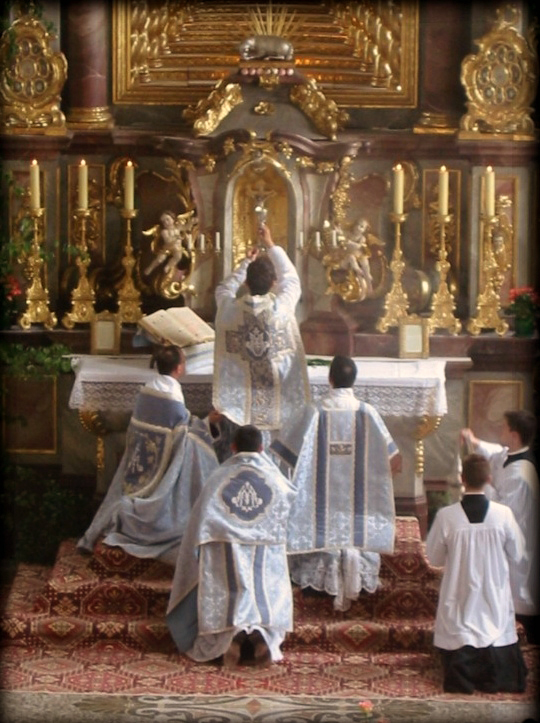
Traditionalist Catholicism
Traditionalist Catholicism is a movement that emphasizes beliefs, practices, customs, traditions, liturgical forms, devotions and presentations of teaching associated with the Catholic Church before the Second Vatican Council (1962–1965).[1][2] Traditionalist Catholics particularly emphasize the Tridentine Mass, the Roman Rite liturgy largely replaced in general use by the post-Second Vatican Council Mass of Paul VI.
This article is about the contemporary movement. For the 19th-century theological position, see Traditionalism (19th-century Catholicism).
Many Traditionalist Catholics disliked the liturgical changes that followed the Second Vatican Council, and prefer to continue to practice pre-Second Vatican Council traditions and forms. Some also see present teachings on ecumenism as blurring the distinction between Catholics and other Christians. Traditional Catholicism is often more conservative in its philosophy and worldview, promoting a modest style of dressing and teaching a complementarian view of gender roles.[3]
Some Traditionalist Catholics reject the current papacy of the Catholic Church, becoming sedevacantists, sedeprivationists, or conclavists. As these groups are no longer in full communion with the Pope and the See of Rome, they are not considered members of the Catholic Church, but instead separate religious groupings.[4][2] A distinction is often made between these groups (sometimes called Radical Traditionalists) and Catholics who accept the teachings and authority of the Catholic Church while still preferring older traditions and practices as well as the Tridentine Mass in Latin.[2]
History[edit]
Toward the end of the Second Vatican Council, Father Gommar DePauw came into conflict with Cardinal Lawrence Shehan, Archbishop of Baltimore, over the interpretation of the council's teachings, particularly on liturgical matters. In January 1965, DePauw incorporated an organization called the Catholic Traditionalist Movement in New York State, purportedly with the support of Cardinal Francis Spellman, Archbishop of New York.[5]
By the late 1960s and early 1970s, conservative Catholics opposed to or uncomfortable with the theological, social and liturgical developments brought about by the Second Vatican Council began to coalesce.[6] In 1973, the Orthodox Roman Catholic Movement (ORCM) was founded by two priests, Francis E. Fenton and Robert McKenna, and set up chapels in many parts of North America to preserve the Tridentine Mass.[6] Priests who participated in this were listed as being on a leave of absence by their bishops, who disapproved of their actions.[6]
In 1970, French Archbishop Marcel Lefebvre founded the Society of Saint Pius X (SSPX), made up of priests who would say only the Traditional Latin Mass and who opposed what he saw as excessive liberal influences in the Church after Vatican II. In 1988, Lefebvre and another bishop consecrated four men as bishops without papal permission, resulting in excommunication latae sententiae for all six men directly involved. Some members of the SSPX, unwilling to participate in what they considered schism, left and founded the Priestly Fraternity of Saint Peter (FSSP), which celebrates the Tridentine Mass and is in full communion with the Holy See. In 2009, Pope Benedict XVI lifted the excommunications of the four surviving bishops.[7]
The Istituto Mater Boni Consilii (IMBC) was founded in 1985. It is a sedeprivationist religious congregation of clergy who were dissatisfied with the SSPX's position on the Pope, i.e., acknowledging John Paul II as pope but disobeying him. Sedeprivationists hold that the current occupant of the papal office is a duly elected pope but lacks the authority and ability to teach or govern unless he recants the changes brought by the Second Vatican Council.[8]
Some Catholics took the position of sedevacantism, which teaches Pope John XXIII and his successors are heretics and therefore cannot be considered popes, and that the Catholic Church's sacraments are not valid. The Society of Saint Pius V (SSPV), sedevacantist, broke off from the SSPX. Another sedevacantist group, the Congregation of Mary Immaculate Queen (CMRI), formed spontaneously among the followers of Francis Schuckardt, but he was later expelled due to scandals and CMRI is now more aligned with other sedevacantist groups.
Other groups known as Conclavists have elected their own popes in opposition to the post-Vatican II pontiffs. They are not considered serious claimants except by their very few followers.